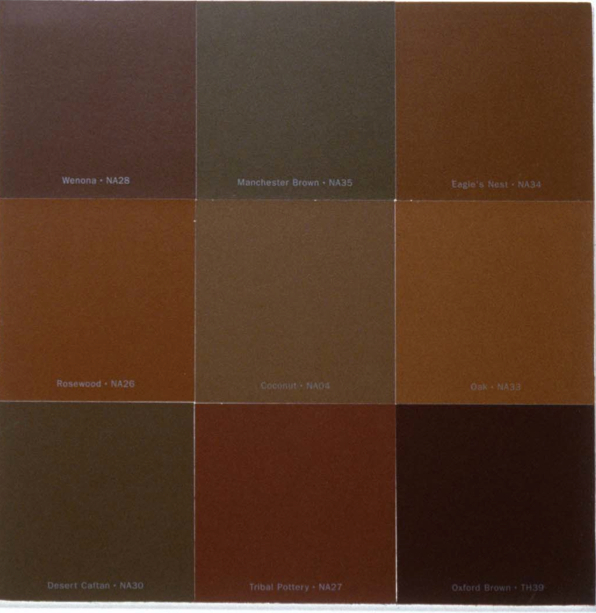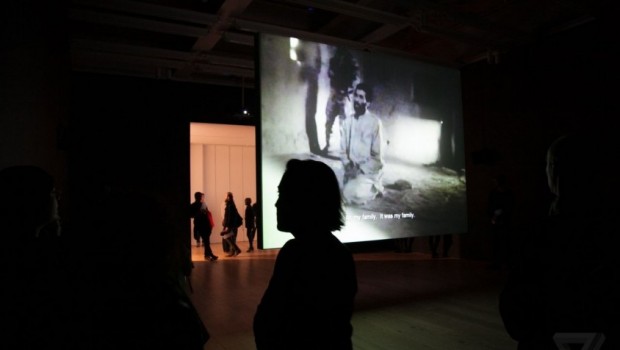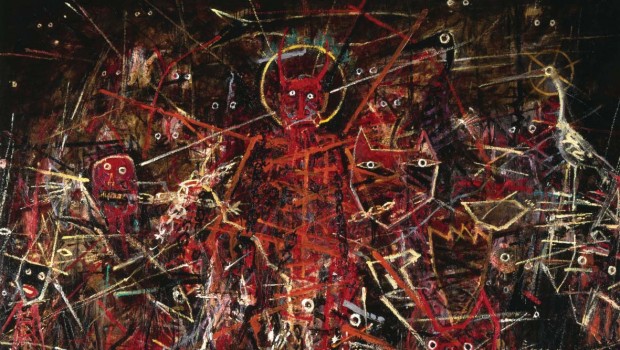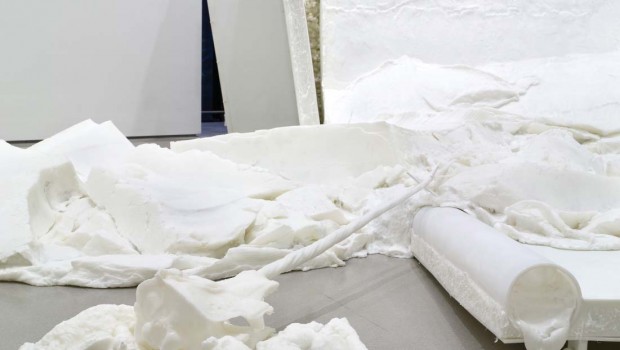The Ideology of Color
Fernando Castro
Download Complete PDF / Descargar
Many of the works of The Ideology of Color arose from Texas ́ history class when one of my Mexican students of Native-American descendance asked me when white people first arrived. Any artist who ever painted people knows that white is perhaps the only color not to be used for human skin –unless you are painting dead people. Even the ghostly skin of Giovanna Cenami in Van Eyck’s The Arnolfini Marriage (1414), is conspicuously different from the truly white headpiece she is wear- ing. After this two-second thought I blurted out, “There are no white people.”
Noticing the skeptical expression on my student’s face I took out a piece of white paper and added, “There is nobody this color.” In order to show my young students how white people would look like if they existed, I decided to make photographs of truly white people. I went through my negatives to see which ones I could use for what would become the White People series. Back in 1988 I had taken pictures of people and their dogs in a canine competition in Peru. These images were fitting because some of the ideas behind the motivation of many people to call themselves “white” are connected to the project of selectively breeding dogs to obtain Dobermans, French Poodles, etc. I painted the skin in the black-and- white negatives with an opaque medium so that they printed totally white.
The White People series is made up of peculiar portraits of dogs and their masters at a canine competition. Each portrait bears the name of the dog’s breed rather than their master ́s name: “English Sheepdog”, “Komondor”, “Great Dane”, etc. In fact, I do not know the name of these dogs’ mas- ters. My yet-unfulfilled hope is to show these pictures in Peru so that people might recognize themselves in them- in spite of having had their faces whitened out – and come forth claiming, “That’s my dog ergo that is I.”
After my students saw these pictures of truly white people they were finally persuaded that people who claim to be white are not really white. Not trusting her eyes, one student asked, “What color are they then?” “They are usually some shade of pink.” “Are we pink too?” asked another student. “Some of us are pink and some of us are some shade of brown: light brown in winter, darker brown after we tan in the sum- mer.” “Are there black people?” “No, nobody is the color of my black shoe. There are only pink people and brown people.” Realizing that we all had skins of slightly different colors, I went to Home Depot and picked up a stack of pink and brown color swatches of wall paints by designer Ralph Lauren. I brought them back to my classroom so that my students and I could match the color of our skins to the swatches.
The search for the color of our skins led me to produce collages about skin color using these paint swatches. I did a few about the color of my skin and about the color of my girlfriend’s skin (She is Polish). Group Portrait is a depiction of Tupac Amaru, Mahatma Gandhi, Nelson Mandela, Geronimo, Martin Luther King Jr., Benito Juarez, Cesar Chavez, Malcolm X, and Gamal Abdel Nasser. I did collages about larger crowds; like Democratic Convention and Republican Convention. I realized that a kind of system of representation had ensued from the conjunction of paint swatches and the handwritten text.
The paint swatches began to suggest to me more than just samples of skin color. Doing Looking for the Color of my Eyes and Looking for the Color of her Eyes liberated me from the self-imposed constraint of not altering the swatches. Real human situations took form: love, hatred, difference, power, etc. Seeing the color of ice blue eyes on pink skin brought me back to certain personal experiences I have had in the United States when I have come upon racist people who are obviously upset about sharing this space with me. I made He Looked at me Under the Mistaken Impression That it Was I Who Did Not Belong Here so I Stared Right Back at Him. On the positive side I also made Lovemaking: two squares of contrasting skins, one overlapping the other.
These experiments in collage-making and the interactions with my students led me to the question: why do people who are pink call themselves “white”? More specifically, why do so many Europeans and their descendants value white-ness so much? I do not have definitive answers but I have a few grounded speculations. For the first question it is important to consider that skin color is one of the least successful European attempts at painting the world white. The most successful one in the New World is the project to rid cotton of its many colors. That such a project even existed was first revealed to me in 1988, when I visited an anthropologist who had recovered cotton seeds from ancient Pre-Columbian tombs on the northern coast of Peru. After germinating these seeds, the cotton that bloomed turned out to have different colors: tan, pink, violet, gray, etc.
When I came to the United States my mother used to complain that she could not find purple maize, yellow potatoes, and other ingredients that were essential for making Peruvian delicacies. Most corn and maize sold in this country was evenly light in color, whereas in the Andean world corn and potatoes come in a multitude of colors. The monochromatic supply in this country is not an accident. Plants have been selectively bred to make homogeneity of the preferred sort possible. This is not the speculative part of my answer, it is factual.
My speculation is that the European obsession for whiteness probably has a theological basis. White is associated with purity, purity with truth and goodness, and truth and goodness with the divine. In the European mind darkness is usually associated with impurity, impurity with evil, and evil with the devil. However, the rhetoric of “evil darkness” in some Christian sects works contrary to personal attire. In these sects bright colors are associated with sensuous sinful- ness and consequently, the pious wear dark clothes (absence of color) to establish their devotion to divine luminous truths. So even though there is a negative bias towards dark skin, there is also a positive bias favoring dark clothes.
Talk and depiction of “white skin” are usually at odds. Medieval depictions of European skin are never intentionally white. One of the few pieces of evidence for white skin in European visual arts are Renaissance marble sculptures; e.g., Michelangelo’s Pieta. But this latter sculpture also shows white clothes that could not possibly be interpreted as white. So the whiteness of the skin is not a similitude but a convention that needs to be interpreted. However, an aesthetic of whiteness did exist in Renaissance and Neo-Classical art by which white objects irradiate a certain luminosity that somehow enhances then.
In fact, the rebirth of classical pagan art during the Renaissance had at least one crucial misunderstanding. As those early “moderns” unearthed Greek statuary and architecture, they internalized an accidental aesthetic of whiteness of art objects that had been discolored by a millennium of aging. It was only in the nineteenth century that new archaeological discoveries like that of the Mausoleum at Halicarnassus in 1862 made Europeans aware that Greek temples and statuary depicting humans were brightly painted. “For during the first half of the nineteenth century archaeologists throughout Europe and Scandinavia had come to realize more and more that Greek architecture and sculpture had indeed been painted and in the most vigorous way.” In fact, the skin of ancient Greeks was painted in an earthy color closer to brown than to pink.
The descriptive use of the word “white” in reference to skin has led to the invention of the racial classification of “white race.” The findings of the Human Genome Project invalidate all notions of “race” as a scientific classification. These works from the Ideology of Color* series also provide an argument against racism from the more empirical realization that there are no white people.
Fernando Castro-Ramírez (Lima, 1952) is an artist, art critic and curator. He has written for El Comercio, Lima Times, Photometro, Art-Nexus, Cámara Extra, Zonezero.com, Artlies, Spot, Aperture, Visible Magazine and other publications. One of his essays is featured in the award-winning book Image and Memory: Photography from Latin America 1867-1994. His works are in the permanent collections of the Houston Museum of Fine Arts, The Dancing Bear Collection, Lehigh University and Museo de Arte.
• In July 2004, The Ideology of Color exhibit was shown at the Centro Cultural Borges in Buenos Aires. A virtual on-line exhibition is currently in production by Lehigh Univerisity.
Posted: April 2, 2012 at 6:39 am











